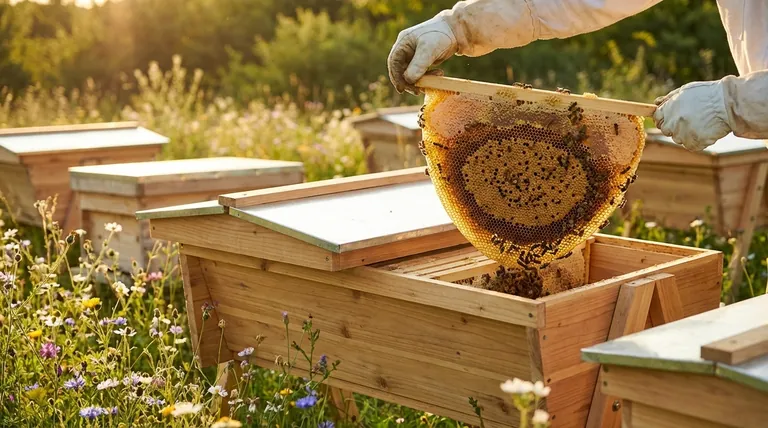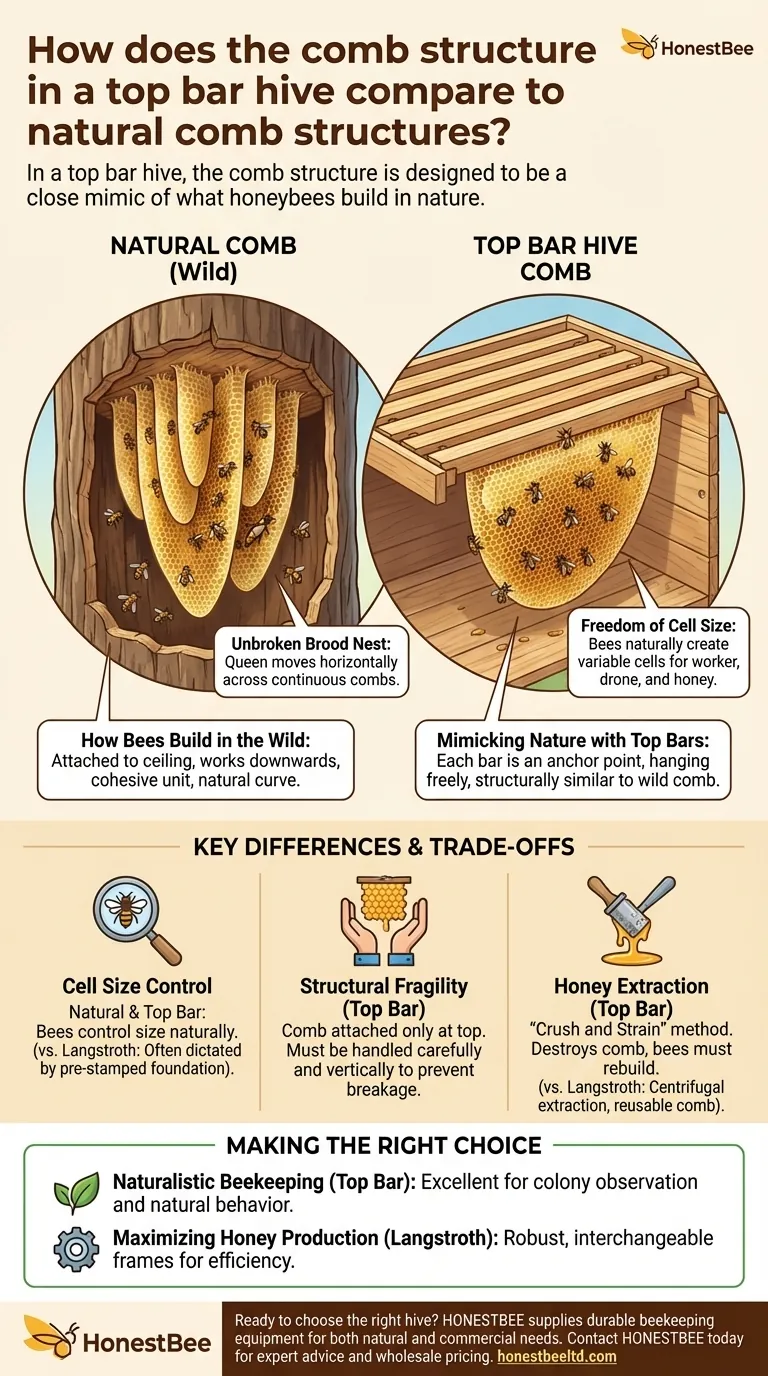In a top bar hive, the comb structure is designed to be a close mimic of what honeybees build in nature. Unlike the rigid, four-sided frames of a conventional Langstroth hive, a top bar hive provides only a single wooden bar for each comb. This allows the bees to draw out their comb downwards in a natural catenary curve, controlling cell size and shape just as they would in a hollow log or tree cavity.
The core difference is one of constraint. A top bar hive allows bees to build a more natural, continuous, and self-organized nest, while a framed hive imposes a rigid, modular structure primarily for the beekeeper's convenience.

The Principle of Natural Comb Construction
To understand the comparison, we must first look at how bees build their home without human intervention.
How Bees Build in the Wild
In a natural cavity, honeybees attach their wax comb to the ceiling of the space. They work downwards, creating a series of parallel combs that hang freely.
This structure is a single, cohesive unit. The bees organize it with a central brood nest, surrounded by a band of pollen, which is then surrounded by honey stores on the periphery.
Mimicking Nature with Top Bars
The top bar hive's design directly emulates this natural architecture. Each bar serves as an anchor point, acting as the "ceiling" of a small section of the hive.
The bees build a single sheet of comb hanging from each bar. Because the comb is only attached at the top, it is structurally very similar to a wild comb.
The Unbroken Brood Nest
This design facilitates a more natural colony organization. The queen can move horizontally across a continuous series of combs, laying eggs in a spherical pattern that expands and contracts with the seasons.
This contrasts sharply with a Langstroth hive, where the brood nest is often broken up by the wooden frames and separated vertically into different boxes.
Key Differences in Comb Characteristics
While visually similar, the implications of this structure create distinct differences in practice.
Freedom of Cell Size
Without the pre-stamped wax foundation often used in frames, bees in a top bar hive build cells of the size they need. They naturally create smaller cells for worker brood, larger cells for drone brood, and variable cells for honey storage.
Comb Shape and Attachment
Natural comb and top bar comb share a characteristic "U" shape dictated by gravity. The bees often leave the sides and bottom of the comb unattached to the hive walls, allowing for air and bee circulation around it.
Understanding the Trade-offs
The natural design of top bar comb comes with significant practical considerations that every beekeeper must understand.
Structural Fragility
Because the comb is only attached to the top bar, it is extremely fragile. A beekeeper must handle the bars carefully during inspections, keeping them perfectly vertical to prevent the comb from breaking off under its own weight.
Honey Extraction Method
Top bar combs cannot be placed in a standard centrifugal extractor, which would immediately shatter them. Honey is harvested using the "crush and strain" method, where the comb is cut from the bar and crushed to release the honey.
This process destroys the comb, meaning the bees must expend resources to rebuild it. In contrast, Langstroth frames are typically preserved and reused year after year.
Making the Right Choice for Your Goal
The choice between a hive that promotes natural comb and one that uses frames depends entirely on your beekeeping philosophy and objectives.
- If your primary focus is naturalistic beekeeping and colony observation: The top bar hive provides an excellent environment to see bees express their innate comb-building and organizational behaviors.
- If your primary focus is maximizing honey production and ease of management: The robust, interchangeable frames of a Langstroth hive are far more practical and efficient for large-scale operations.
Ultimately, understanding how a hive influences comb structure is the first step toward aligning your beekeeping practices with your specific goals.
Summary Table:
| Feature | Top Bar Hive Comb | Natural Comb (Wild) | Langstroth Hive Comb |
|---|---|---|---|
| Structure | Single sheet, hanging from a bar | Single sheet, hanging from cavity ceiling | Rigid, four-sided frame |
| Cell Size Control | Bees control size naturally | Bees control size naturally | Often dictated by pre-stamped foundation |
| Brood Nest | Continuous, unbroken | Continuous, unbroken | Modular, often broken by frames |
| Handling & Durability | Fragile, requires careful inspection | N/A (not handled) | Robust, easy to inspect and extract |
| Honey Harvesting | Crush and strain method | N/A | Centrifugal extraction (reusable comb) |
Ready to choose the right hive for your beekeeping philosophy?
Whether you manage a commercial apiary focused on honey production or are a distributor supplying beekeepers who value natural methods, HONESTBEE has the equipment you need. We supply durable, wholesale-focused beekeeping supplies to help you succeed.
- For Natural Beekeeping: Explore our top bar hive components to support colony health and natural comb building.
- For Commercial Efficiency: Discover our robust Langstroth hive equipment designed for maximum productivity.
Let's discuss your specific needs. Contact HONESTBEE today for expert advice and wholesale pricing on reliable beekeeping supplies.
Visual Guide

Related Products
- Long Langstroth Style Horizontal Top Bar Hive for Wholesale
- Top Bar Beehive for Beekeeping Wholesales Kenya Top Bar Hive
- HONESTBEE Professional Multi-Functional Hive Tool with Ergonomic Wood Handle
- HONESTBEE Advanced Ergonomic Stainless Steel Hive Tool for Beekeeping
- HONESTBEE Professional Long Handled Hive Tool with Precision Cutting Blade
People Also Ask
- What are the advantages of a top bar hive? Simpler, Bee-Centric Beekeeping for All
- What are the main differences between Langstroth hives and top bar hives? Choose the Right Hive for Your Beekeeping Goals
- What are the benefits of a top bar hive? A Natural, Low-Impact Approach to Beekeeping
- How does the top bar hive help control varroa mites? A Natural Approach to Mite Management
- What is a top bar bee hive? A Natural, Low-Stress Beekeeping Solution



















